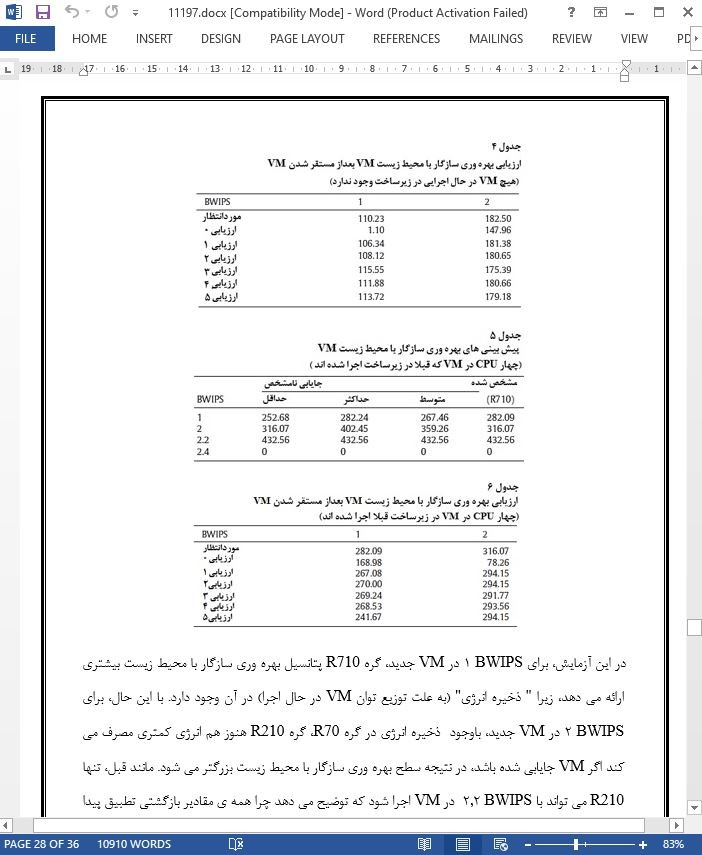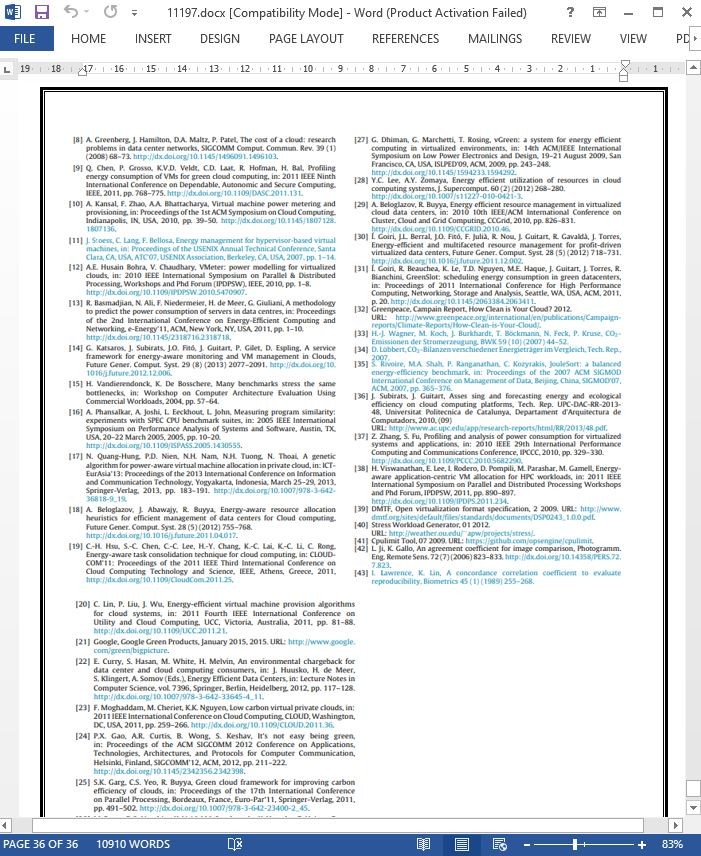
پیش بینی و برآورد بهره وری اکولوژیک ماشین های مجازی
چکیده
توسعه عظیم فروشگاه مجازی ابری به افزایش تعداد مراکز داده ها (DC) در سطح جهانی و در نهایت به افزایش جای پای گاز CO2 منجر شده است. محاسبه اثر ماشین های مجازی (VM) بر محیط زیست کاری چالش برانگیز، نه تنها باتوجه به مشکلات فنی بلکه باتوجه به نبود اطلاعات از ارائه دهندگان انرژی می باشد. بهره وری اکولوژیک از رابطه بین عملکرد سیستم با جای پای زیست محیطی آن بدست می آید. در این مقاله ما یک روش برای تخمین و پیش بینی بهره وری اکولوژیک VM ها در زیرساخت های ابری خصوصی ارائه داده ایم. ما بطور خاصی بر مدیریت اطلاعات منابع انرژی در یک ناحیه، مصرف انرژی و عملکرد منابع و درنهایت محاسبه اکولوژیک یک VM متمرکز شده ایم. برای این منظور، ما به طراحی و اجرای چارچوبی از طریق بهره وری اکولوژیک یک VM پرداخته ایم که می توان آن را ارزیابی کرد و می توان به پیش بینی بهره وری اکولوژیک یک VM گسترش یافته پرداخت. چارچوب ارائه شده از طریق چند سناریو ابر خصوصی با استقرار VM در فضای واقع شده در آلمان مورد بررسی قرار گرفته است.
1 . مقدمه
رشد سریع خدمات کاربردی تکنولوژی ارتباطات و اطلاعات ( ICT ) همراه با افزایش تعداد مراکز داده ها (DC) که میزبان این خدمات هستند انجام می شود. زیرا مراکز داده های مصرف کننده گان دارای انرژی عظیمی می باشد و از طرفی جای پای کربن در خدمات کاربردی درحال بیشتر شدن است و تمرکز بر روی آن بیشتر شده است. در حال حاضر ICT باعث انتشار حدود 2 درصد گاز کربن در سطح جهانی می شود( بیش از 380 میلیون تن دی اکسید کربن)[1,2]. ظهور الگوی رایانش ابری باعث تقویت بخش خدمات شده است بطوری که پیش بینی می شود در سال 2020 بازارهای مجازی (SaaS ، PaaS ، LaaS) نسبت به امروزه چهار برابر خواهند شد.
5 . نتیجه گیری
در این مقاله ما اثرات زیست محیطی منابع ابر و بطور خاص تکنیک های اندازه گیری و نظارت بر جای پای گاز CO2 ماشین های مجازی را در زیرساخت های رایانش ابر بررسی کرده ایم. ما بهره وری اکولوژیک VM ها را به عنوان معیاری سنجشی که بطور موثری اثرات را تعیین می کند شناسایی می کنیم و ما این معیار سنجش را با استفاده از انرژی و عملکرد مرتبط با پارامترهای سیستم میزبان مدل می کنیم. برای این منظور، ما ساختار خدماتی ارائه دادیم که اجازه می دهد بر بهره وری سازگار با محیط زیست VMها در سناریوهای ابر خصوصی نظارت کنیم. سیستم طراحی شده اطلاعات را از داده های ذخیره انرژی عمومی و داده های پیشین هر کشور به منظور تعیین عوامل انتشار گاز CO2 در هر منطقه جمع آوری می کند. از طریق این روش ما قادر به محاسبه بهره وری سازگار با محیط زیست VMها در یک مکان و در زمان خاص هستیم.
Abstract
The massive development of the cloud marketplace is leading to an increase in the number of the Data Centers (DCs) globally and eventually to an increase of the CO related footprint. The calculation of the impact of Virtual Machines (VMs) on the environment is a challenging task, not only due to the technical difficulties but also due to the lack of information from the energy providers. The ecological efficiency of a system captures the relationship between the performance of the system with its environmental footprint. In this paper we present a methodology for the estimation and prediction of the ecological efficiency of VMs in private cloud infrastructures. We specifically focus on the information management starting from the energy resources in a region, the energy consumption and the performance of the resources and finally the calculation of ecological efficiency of a VM. To this end, we have designed and implemented a framework through which the ecological efficiency of a running VM can be assessed and the ecological efficiency of a VM to be deployed can be forecasted. The presented framework is being evaluated through several private cloud scenarios with VM deployments in hosts located in Germany.
1. Introduction
The rapid growth of ICT application services goes along with an increase in number and size of data centers (DCs) that host these services. Because data centers are massive energy consumers, the carbon footprint of application services is moving more and more into focus. It is considered that ICT presently accounts for approximately 2% of global carbon emissions (more than 830 million tons of carbon dioxide) [1,2]. The advent of the cloud computing paradigm gave an enormous boost to the ICT services sector and the prediction towards 2020 is that the market (SaaS, PaaS, IaaS) will quadruple from what it is today.
5. Conclusions
In this paper we investigated the environmental impact of cloud resources and specifically about techniques to measure and monitor the CO2 footprint of virtual machines in cloud computing infrastructures. We identified ecological efficiency of VMs as the metric that effectively defines such impact and we modeled this metric using energy and performance related parameters of the hosting system. To this end, we proposed a service architecture which allows monitoring the eco-efficiency of VMs in private cloud scenarios. The designed system aggregates information from public energy data-stores and historical data for each country in order to define the CO2 emission factors for each region of interest. Through this methodology we are able to calculate the eco-efficiency of VMs in a location and time specific manner.
چکیده
1 . مقدمه
2 . حالتی از طرح و کار مرتبط
3 . نظارت بر بهره وری اکولوژیک در ابرها
3 . 1 مرحله جمع آوری : تولید بایگانی انتشار گاز CO2
3 . 2 مرحله نظارت (i): ارزیابی بهره روی سازگار با محیط زیست برای اجرای VMها
3 .3 مرحله نظارت (ii): پیش بینی بهره وری سازگار با محیط زیست برای گسترش پتانسیل VM
4. ارزیابی
4 . 1 بررسی ارزیابی بهره وری سازگار با محیط زیست
4 . 2 ارزیابی پیش بینی های بهره وری سازگار با محیط زیست
5 . نتیجه گیری
Abstract
1. Introduction
2. State of the art and related work
3. Monitoring ecological efficiency in clouds
3.1. Aggregation phase: creation of the CO2 emission registry
3.2. Monitoring phase (i): assessment of eco-efficiency for running VMs
3.3. Monitoring phase (ii): prediction of eco-efficiency for potential VM deployments
4. Evaluation
4.1. Evaluation of eco-efficiency assessments
4.2. Evaluation of eco-efficiency forecasts
5. Conclusions
- ترجمه فارسی مقاله با فرمت ورد (word) با قابلیت ویرایش، بدون آرم سایت ای ترجمه
- ترجمه فارسی مقاله با فرمت pdf، بدون آرم سایت ای ترجمه



